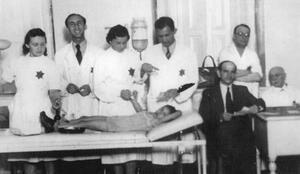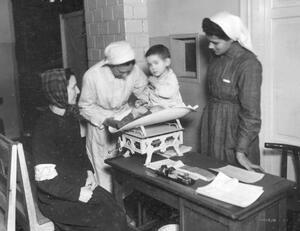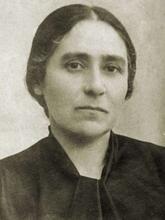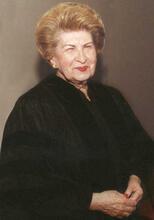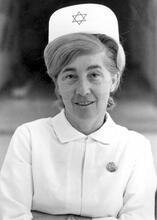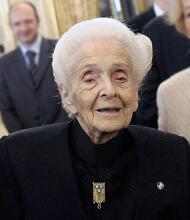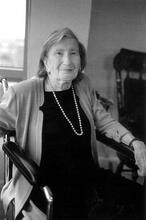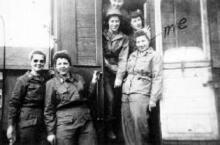Women's Health in the Ghettos of Eastern Europe
Women in the ghettos of Eastern Europe often outnumbered men, but within ghetto populations, women generally had lower mortality rates than men, perhaps due to their ability to adapt to their surroundings and use of public health services. However, women’s suffering was unique due to their sex. Most women did not menstruate while in the ghettos, and those who suffered from this condition for an extended period of time risked never menstruating again or having severe physical ailments if their cycle restarted. While many women did not want to bear children in such a harsh environment, some conceived by mistake, pushing them into an even worse position. Decrees prohibiting childbirth in some ghettos made abortions, often under unsanitary conditions and with improper methods, extremely common.
Introduction
Occupying Nazi forces in in Eastern Europe forced Jewish populations into ghettos, extending the physical restrictions placed on Jews under the Nazis that started in Germany in 1933. These ghettos were known for their brutal conditions, and one of the main effects of ghetto life on individuals was the deterioration in their health. Overcrowded living conditions, malnutrition, poor sanitation, hard labor, along with harsh weather, the absence of any reasonable health and nursing care all contributed to making the ghetto fertile ground for the spread of disease and the decline in the health of the individual.
These unhealthy conditions were deliberate German policy, meant to bring about the gradual extermination of the Jewish population via the spread of disease (Trunk, 1953). Also, the supposed need to protect the non-Jewish public in occupied areas from the “disease-bearing” Jews gave the occupation authorities a convenient pretext for forcing the Jews into ghettos. Ghetto living conditions, which caused the accelerated spread of disease along with the prejudiced, racist attitude toward the Jews as spreaders of disease, ultimately became a self-fulfilling prophecy.
Gendered Population and Mortality Rates
In many Eastern European ghettos, the number of women in the ghetto population was greater than that of the men. In the Warsaw ghetto, for example, there were 211,492 women and 157,410 men. Similarly, census data for the Lodz ghetto from June 1940 shows that women accounted for 54.4 percent while men made up 45.5 percent of the total population; a similar gender breakdown occurred in the Kovno ghetto. A report from the Kovno ghetto’s labor department in 1943 indicated that as the age of the population rose, the gap between men and women increased to between forty and sixty percent. In Poland, which was occupied in 1939, this phenomenon is partly due to the drafting of many men to the Polish army, their seizure for forced labor, and the fact that many Jewish men fled in fear of their lives when the Germans entered the occupied zones. In the areas under Soviet control, the greater proportion of female ghetto residents was because Jewish men were among the first targets for mass murder by local nationalists along with the German occupiers.
Yet as time went on, the gap between men and women in the ghettos continued to increase, mainly because the persistent increase in mortality was especially prevalent among men. Dr. Emanuel Ringelblum (1900–1944) described in his journal the great increase in mortality in the Warsaw ghetto, which was especially common among the poor. At the end of August 1941, he noted in his journal: “It often happens that an entire family dies in one day or over a few days. The number of orphans is increasing since the adults die first, especially the men.” In July 1942, the following was written in the chronicles of the Lodz Ghetto: “There is a marked increase in the number of women in relation to that of men. This is because the mortality among men is double that of the women, and because of the labor transports.” Similarly, scholar Michal Unger describes how men comprised both the vast majority of the 11,000 people transported to labor camps outside the ghetto and the group most affected by the marked increase in mortality.
Despite the reservations expressed by researchers concerning the exactitude of the data on mortality in the Warsaw ghetto, it turns out that the mortality rate for women in the Warsaw ghetto was lower than that of the men. An exception is at the refugee concentration points (“punkti”) in the Warsaw ghetto, which ranged between 9,500 (recorded) and 20,000 residents. Official data indicate that from November 1941 through January 1942, 458 men and 528 women died. However, the higher number of women who died simply reflected the high percentage of women in the refugee concentration points. In June 1942, for example, 41 percent of the residents in all the “points” in the Warsaw ghetto were women, as opposed to 21 percent men and 38 percent children. One of the most extreme cases of death in refugee shelters was at 14 Ostrovsky Street where, by January 1942, all the men had died and only women and children remained. This high mortality rate among the refugees was due to starvation, tuberculosis, and various kinds of typhus.
In 1942, 264 people died in the Vilna ghetto hospital. Of them, 58 percent were male and 42 percent were female; most of the dead were children under five and those over 60 years of age. In November of the same year 28 people died, of whom eighteen were men and ten were women, mostly adults over fourteen years of age. In the Kovno ghetto, 235 people died between November 1, 1941, and May 1, 1942, including 104 out of a total population of 9,898 women, in contrast with 134 out of a total population of 7,469 men.
It appears, then, that despite the fact that men were a minority in ghetto populations, their relative and nominal proportion among those who died was higher than that of the women. However, in the Lodz and Warsaw ghettos, death became a routine matter. The mortality rate in the Lodz ghetto stood at twenty-one percent of the residents and was the highest of all the ghettos in Poland. The mortality rate in the Warsaw ghetto was also high, with an average of seventeen percent. Most of those who died succumbed to starvation, weakness, and disease, and women were not exempt from these high death rates. But mortality rates were lower in the Krakow, Bialystok, Grodno, Vilna, Kovno, and Shavli ghettos. In these ghettos, the local Jewish council and medical staff managed to prevent the spread of disease to uncontrollable proportions and staved off death as much as possible.
How to explain the gap in mortality between men and women in the ghettos? Even under ordinary circumstances, women’s life expectancy is higher than that of men. According to Michal Unger, men’s work in the ghettos was more physically difficult in many cases, causing weakened resistance and accelerated mortality. An exception was the Kovno ghetto, where the proportion of women in forced-labor groups who worked outside the ghetto was not significantly lower, if at all lower, than that of the men. Even so, based on journal testimonies written in Kovno, Unger finds that women’s ability to adapt to the surrounding reality was better, as was their ability to cope with hunger and the changing conditions.
Researcher Felicia Karai found that “Women grasped, more quickly and intuitively, that ‘this was another sort of war,’ and they had to save all whom they could. … Several feminine traits made it easier for them to cope with the difficult situation better than the men: resignation in the face of helplessness, greater adaptability, feminine charms and the ability to develop contacts with their surroundings (sometimes even with the Germans), and all this in addition to their physical advantages: biological strength, more attention to their physical appearance and to cleanliness.” Indeed, a study of the patients’ roster in the Vilna ghetto hospital for December 1942 showed that, of the 3,001 patients hospitalized, 1,382 were men and 1,619 were women, but the mortality rate was four percent higher among men than among women. Therefore, in contrast to the mortality rate, the incidence of disease was not lower among women. Moreover, women knew how to make use of the public health services provided.
Disease in the Ghettos
Two main factors were responsible for the increase in the incidence of disease in the ghettos. One was existence in the ghetto itself, and the other was forced labor. From journals and memoirs written by physicians in the ghetto, we cannot unequivocally determine what specific factor, other than physiological injury, rendered ghetto residents vulnerable to disease through decreased immune capacities. The unusual living conditions in every ghetto, its population characteristics, and the importance of productivity as a main component of continued existence are also important factors to consider. In the Warsaw ghetto, where residents suffered from long-term starvation, there was a dramatic increase in hunger-related diseases such as tuberculosis. Similarly, severe living conditions in the Lodz ghetto affected the spread of various kinds of typhus. In the Lublin ghetto in 1941, ten percent of the population contracted typhus. The same year, the spread of the disease reached 14.3 percent of the Jewish population in the Kutno ghetto. This reality affected the health of the women in these ghettos and forced them to cope with the new circumstances and the subsequent change in their physical health.
Female-Specific Health Issues
Dr. Yaakov Nakhimovsky, chairman of the medical committee located near the labor office in the Kovno ghetto, conducted medical observations during 1942 and 1943 among the workers in the ghetto, with emphasis on the relationship between work and the incidence of disease. Nakhimovsky also dealt in his studies with diseases common to women. Because of their light clothing and work in open areas, to which they were not accustomed, women suffered from burns, severe skin infections, and high fevers. During the winter, the long marches to and from work in the severe cold, wet clothing, and damp, unsuitable shoes caused complications. These conditions were worsened by the absence of the proper nutrition necessary for recovery. Yet despite this, Dr. Nakhimovsky determined that these diseases were not fatal.
The physicians’ surveys show clearly that one of the outstanding physiological effects on the health of women in the ghettos (and afterward in the camps) was amenorrhea, the cessation of menstruation. Nakhimovsky finds that during the move to the ghettos, most women of child-bearing age suffered from amenorrhea. Dr. Aharon Peretz, who served as a gynecologist in the Kovno ghetto, claimed that emotional stress and hard labor caused changes in the function of the endocrine system and therefore the cessation of monthly cycles for the women in the ghettos. Dr. Mark Dworzecki, a physician in the Vilna ghetto, related how the explanation for amenorrhea caused heated arguments among the doctors. Some believed that it was due to emotional experiences, changes in the secretion of hormones, and lack of vitamins. Some believed that it was irreversible and stable, while others believed it was temporary. Indeed, Dworzecki found that with improvement in nutrition and a reduction in aktions, incidence of amenorrhea decreased for some women.
From a wide-ranging survey of starvation-related diseases conducted by physicians in the Warsaw ghetto, it appears that during heavy bombardments of the city, many women ceased to menstruate. According to the physicians, these occurrences were temporary under ordinary conditions, but during an extended period of malnutrition they became permanent. The prevailing belief among the medical staff in the Warsaw ghetto was that lack of vitamin A was responsible for amenorrhea, which studies of young girls in orphanages proved. Dr. Nakhimovsky determined that over time, menstruation returned to normal for some of the women but because of women’s deteriorating physical health in the ghetto, their menstruation was accompanied by pain and other physical ailments.
Nakhimovsky emphasized that the hormonal disturbances women suffered in the ghetto affected their thyroid gland. He referred to this issue, prevalent among ghetto women, as the Bazedow condition (a disorder of the thyroid gland). It was possible to diagnose this condition in all its stages, from light cases to more severe ones, and it persisted all the time the ghetto existed. “The main sufferers were mainly girls and young women. There were irregularities in heart function and the nervous system; hair loss, excessive sweating and high fever, which were caused mainly by emotional shock.” Tetanus was prevalent among young girls in the ghetto, though it passed in time. “It is difficult to determine whether [tetanus] was caused by poor nutrition or by poor functioning of the thyroid gland,” he wrote in his survey. Research on starvation done in the Warsaw ghetto found that starvation harmed the thyroid gland, which blurred the physiological characteristics of both sexes. Young girls developed hair on their upper lips and cheeks, and the development of their pelvic areas was delayed.
Pregnancy and Childbirth
In addition to amenorrhea, the women of the Lodz ghetto developed a strong desire not to bear children in such a cruel and unstable world, according to Michal Unger. Due to this preference, birth rates in the ghetto were extremely low; only 2,306 babies were born in ghetto during its four-year existence. In early 1942, authorities issued a decree prohibiting the birth of children in the Vilna, Kovno, and Shavli ghettos. This order corresponded with statements written in December 1941 by commander Karl Jäger (1888–arrested in 1959; suicide). Regarding the Jewish labor force that remained in Lithuania after the mass murders, he wrote, “I believe that we should begin sterilizing male Jews from among the Jewish laborers to prevent future increase. If a Jewish woman should become pregnant, she should be killed.”
The decrees against pregnancy and childbirth, along with the fatalistic attitude in the face of uncertainty, left their mark on gynecology practiced in the ghettos. The gynecological department of the Vilna ghetto operated mainly to terminate pregnancies, according to Dr. Shadowsky. In cases of advanced pregnancy, the women were brought to the hospital forcibly by the ghetto police. Of the 429 women hospitalized in the Vilna ghetto in 1942, more than 60 percent were abortion cases. Dr. Moshe Figenberg, a gynecologist in the ghetto, stated in his testimony: “Because the death penalty loomed over any woman who gave birth in the ghetto, the women’s department in the hospital where I worked was loaded down with abortion cases.” Because of the large number of pregnancies, the Vilna ghetto’s health office helped with various forms of birth control. In the beginning, they evaded the decree by means of false records. In time, a campaign began that included lectures by ghetto doctors on various ways to prevent pregnancy. In addition, the health office opened a counseling center for women where they could obtain birth-control devices developed by one of the ghetto physicians.
In the Kovno ghetto, the health department arranged the required medical services for terminating pregnancies. In addition, the medical staff was also responsible for public-relations efforts and warning women of what awaited them, but quite a few women refused to give in to the decree. They went underground in order to evade the prohibition, and with the help of the medical committee located near the ghetto labor department, they were released from their work obligations until they delivered their babies in secret. Dr. Aharon Peretz, one of the gynecologists in the ghetto, said that many pregnancies were among women who had suffered from amenorrhea and were unaware that they could still conceive. Another reason for these pregnancies was the absence of birth-control methods. Peretz reported that due to the shortage of proper medical care in the ghetto, some of the operations were performed in the strangest and dreadful conditions. Deliveries were performed in secrecy mainly by specially trained midwives, while doctors were called only in cases of severe complications.
In the Shavli ghetto the decrees forbidding pregnancy and childbirth caused much anxiety, and therefore the senior gynecologist of the ghetto, Dr. Josef Luntz, developed a special system for terminating pregnancies and speeding deliveries via “primitive” mechanical means. According to Luntz, his methods worked; the women did not become ill and the babies were born without harm. But Dr. Aharon Pick (1872–1944), a senior physician in the Shavli ghetto, reported in the journal he left behind many incidents where women submitted complaints to the ghetto court about severe complications caused by negligence in abortions. Similarly, some of the women of the Shavli ghetto mentioned the terrible conditions they had to endure when they gave birth or terminated their pregnancies.
As time went on, enforcement of the anti-childbirth decree in the Kovno and Shavli ghettos became extreme, and women in advanced pregnancy were forced to deliver early. The sources show that many times, ghetto doctors were forced to kill newborns for fear of collective punishment if a live baby was found among them. These wretched episodes happened while the Kovno and Shavli ghettos were being transformed into quasi-concentration camps and placed under the SS authority.
Conclusion
The state of women’s health in the ghetto was dictated in most cases by the unusual circumstances under which every ghetto existed. The prolonged starvation from which the Warsaw and Lodz ghetto populations suffered, in addition to the hermetic disconnection from the environment outside the Lodz ghetto, left their mark on women’s health, with a sizeable proportion sickened and died following the prolonged weakening of their physical resistance. In ghettos with younger populations and relatively reasonable nutrition, women’s lower mortality rate stands out along with the overall inestimably lower mortality rates than the Warsaw and Lodz ghettos.
A unique and tragic topic was how the women coped with pregnancy and childbirth in extreme deprivation, forced labor, disintegration of the family unit, as well as risk to their own and their families’ lives if a baby should be born. However, it seems that in comparison with men, women managed to cope better with the adverse circumstances under which they labored. Despite the level of physical harm women in ghettos endured and their exposure to disease, which was not always less than the men’s, we can see that their wise use of the ghetto medical services contributed significantly to their well-being.
Balberishsky, M. Stronger than Iron (Yiddish). Tel Aviv: 1967.
Dvorzecki, Mark. “Jerusalem of Lithuania” [Vilna] in Rebellion and Annihilation (Hebrew). Tel Aviv: 1951.
Karai, Felicia. “Women in the Krakow Ghetto” (Hebrew). Yalkut Moreshet 71 (April 2001).
Nachimovsky, Yaakov. “Medical Examinations at the Employment Office of the Kovno Ghetto” (Yiddish). Fun Letzten Hurban (10): Munich: 1948, 28–37.
Perchikovitch, A. “Medical Aid in the Ghetto and Camp.” In Lita (Yiddish). New York: 1951, 1720–1721.
Preis, Leah. Medicine and Health in the Vilna, Kovno and Shavli Ghettos (1941–1944): Between the “Final Solution” and Productivity (Hebrew), M.A. diss., Jerusalem: 1989.
Sakowska, R. Menschen im Ghetto: Die judische Bevolkerung im besetzten Warschau 1939–1943. Osnabruck: 1999.
Schwartz, Daniel B. "The Nazi Ghettos of the Holocaust." In Ghetto: The History of a Word, 125-62. Cambridge, MA; London, England: Harvard University Press, 2019.
Shadowsky, R. “Organization of First Aid and Medical Help in the Vilna Ghetto” (Yiddish). Bletter vegen Vilna. Lodz: 1947: 31–37.
Trunk, Isaiah. “War against Jews Through Spreading of Infectious Diseases.” YIVO Bletter 27 (1953), 93.
Unger, Michal. “The Status and Plight of Women in the Lodz Ghetto.” In Women in the Holocaust, edited by Lenore Weitzman and Dalia Ofer, 123–124. New Haven: 1998.
Winick, M., ed. Hunger Disease: Studies by Jewish Physicians in the Warsaw Ghetto. New York: 1979.

